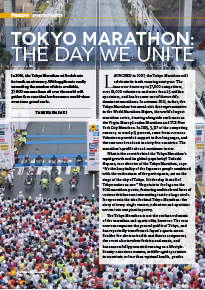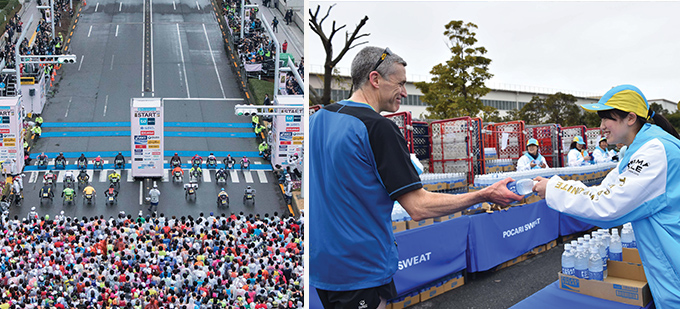Home > Highlighting JAPAN >Highlighting Japan October 2015>Sporting Nation
Highlighting JAPAN

Sporting Nation
Tokyo Marathon: The Day We Unite
In 2016, the Tokyo Marathon will celebrate its tenth anniversary. With applicants easily exceeding the number of slots available, 37,000 runners from all over the world will gather for a race that has become a world-class event on a grand scale.

Launched in 2007, the Tokyo Marathon will celebrate its tenth running next year. The race now draws up to 37,000 competitors, over 10,000 volunteers and more than 1.5 million spectators, and has become one of the world’s dominant marathons. In autumn 2012, in fact, the Tokyo Marathon became Asia’s first representative in the World Marathon Majors, the world’s largest marathon series, drawing alongside such races as the Virgin Money London Marathon and TCS New York City Marathon. In 2015, 5,317 of the competing runners, or nearly 15 percent, came from overseas. Volunteers provided support in five languages, and the race was broadcast in sixty-five countries. The marathon’s profile abroad continues to rise.
What is the secret behind the Tokyo Marathon’s rapid growth and its global popularity? Tadaaki Hayano, race director of the Tokyo Marathon, says: “It’s the hospitality of the Japanese people combined with the enthusiasm of the participants, set on the stage of the city of Tokyo. It’s the day that all of Tokyo unites as one.” He points to the logo on the 2016 marathon poster, featuring multicolored lines of various thicknesses intersecting inside a large circle. It represents the ideal behind Tokyo Marathon: the story of every single runner, volunteer and spectator woven into one giant tapestry.
The Tokyo Marathon is not the exclusive domain of the marathon and sports elite, however. The race now encompasses the general public of Tokyo, and has reportedly transformed Japan’s sports scene. Besides the obvious health and fitness component, the event also involves fashion and music, and has successfully promoted running as a lifestyle. Beauty-conscious women, middle-aged spectators in uncertain or less-than-optimal health, youths searching for a way to break free from the tedium of everyday existence: watching the Tokyo Marathon energizes them all, creating a phenomenon where spectators are inspired to get out and run. Thanks to the marathon, everyday citizens enjoying the sport of running has become a common sight in Japan.
The Tokyo Marathon is now a destination for runners not only from Japan but from elsewhere in Asia, the Middle East, Europe and North and South America as well. The rate of acceptance, awarded by lottery, has decreased to less than 10 percent. The race course features a highly scenic tour of sights in Tokyo’s beautiful and well-maintained urban landscape: the Tokyo Metropolitan Government Office, the Imperial Palace, Tokyo Tower, the Ginza District, Asakusa and more, making it popular among runners from abroad. A survey of participants after the race also revealed a strong appreciation for the constant cheers and support of the Japanese audience along the route, as well as the warm and courteous hospitality of marathon volunteers. Many runners bring their families to Japan to partake in the full array of events occurring before and after the marathon during Tokyo Marathon Week, seeing their journey to Japan as an opportunity for some serious shopping and tourism.
More and more multilingual documents, signs and volunteers are provided every year. Race officials are also vigilant when it comes to safety. Hayano proudly mentions the marathon’s “running police” and “run doctors”—“the only such organizations in Japanese sports,” he claims—as part of a flawless antiterrorism strategy. He also notes that many runners from abroad who have won entry slots in the Tokyo Marathon lottery say they’ve long dreamed of being in the race, and are overjoyed that their wish has finally been granted.
The Tokyo Marathon is in a constant state of evolution. To help spread Western-style charity culture throughout Japan, the race offers a number of charity entry slots through which donations can be made to such services as the Sports Legacy Program, which works to help people reach their dreams through sports. With an eye to the Tokyo Olympics and Paralympics coming in 2020, the marathon is aiming to build a sustainable sports culture.
Hayano expresses confidence in the marathon’s achievements so far. “Our goal is to create the most exciting, welcoming, secure and enjoyable race in the entire world,” he states. Just as with the new logo design formed from every story in the tapestry, the story that unfolds on this blank canvas will depend on its participants.
© 2009 Cabinet Office, Government of Japan






